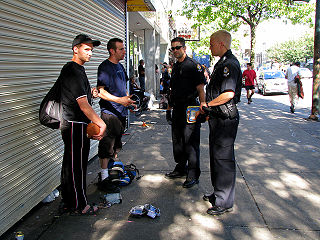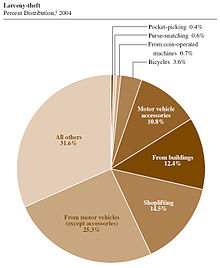
Theft is the act of taking another person's property or services without that person's permission or consent with the intent to deprive the rightful owner of it. The word theft is also used as a synonym or informal shorthand term for some crimes against property, such as larceny, robbery, embezzlement, extortion, blackmail, or receiving stolen property. In some jurisdictions, theft is considered to be synonymous with larceny, while in others, theft is defined more narrowly. A person who engages in theft is known as a thief.
Robbery is the crime of taking or attempting to take anything of value by force, threat of force, or by use of fear. According to common law, robbery is defined as taking the property of another, with the intent to permanently deprive the person of that property, by means of force or fear; that is, it is a larceny or theft accomplished by an assault. Precise definitions of the offence may vary between jurisdictions. Robbery is differentiated from other forms of theft by its inherently violent nature ; whereas many lesser forms of theft are punished as misdemeanors, robbery is always a felony in jurisdictions that distinguish between the two. Under English law, most forms of theft are triable either way, whereas robbery is triable only on indictment. The word "rob" came via French from Late Latin words of Germanic origin, from Common Germanic raub "theft".
Burglary, also called breaking and entering (B&E) and housebreaking, is the act of illegally entering a building or other areas without permission, typically with the intention of committing a further criminal offence. Usually that offence is theft, larceny, robbery, or murder, but most jurisdictions include others within the ambit of burglary. To commit burglary is to burgle, a term back-formed from the word burglar, or to burglarize.
Embezzlement is a term commonly used for a type of financial crime, usually involving theft of money from a business or employer. It often involves a trusted individual taking advantage of their position to steal funds or assets, most commonly over a period of time.
An inchoate offense, preliminary crime, inchoate crime or incomplete crime is a crime of preparing for or seeking to commit another crime. The most common example of an inchoate offense is "attempt". "Inchoate offense" has been defined as the following: "Conduct deemed criminal without actual harm being done, provided that the harm that would have occurred is one the law tries to prevent."
In criminal law, the intoxication defense is a defense by which a defendant may claim diminished responsibility on the basis of substance intoxication. Where a crime requires a certain mental state to break the law, those under the influence of an intoxicating substance may be considered to have reduced liability for their actions. With regard to punishment, intoxication may be a mitigating factor that decreases a prison or jail sentence. Numerous factors affect the applicability of the defense.
Criminal conversion is a crime, limited to parts of common law systems outside England and Wales, of exerting unauthorized use or control of someone else's property, at a minimum personal property, but in some jurisdictions also applying to types of real property, such as land or to patents, design rights and trademarks. It differs from theft in that it does not include the element of intending to deprive the owner of permanent possession of that property. As such, it is a lesser offense than the crime of theft. Criminal conversion specifies a type of conversion in that it involves criminal law, not civil law.
A citizen's arrest is an arrest made by a private citizen – that is, a person who is not acting as a sworn law-enforcement official. In common law jurisdictions, the practice dates back to medieval England and the English common law, in which sheriffs encouraged ordinary citizens to help apprehend law breakers.
In criminal law, property is obtained by false pretenses when the acquisition results from the intentional misrepresentation of a past or existing fact.

The Theft Act 1968 is an act of the Parliament of the United Kingdom. It creates a number of offences against property in England and Wales.
Dishonesty is acting without honesty. The term describes cheating, deficient probity, lying, deliberate withholding of information, being deliberately deceptive, or showing knavishness, perfidiousness, corruption, treachery, or deficient integrity.
The "Bloody Code" was a series of laws in England, Wales and Ireland in the 18th and early 19th centuries which mandated the death penalty for a wide range of crimes. It was not referred to by this name in its own time; the name was given later owing to the sharply increased number of people given the death penalty, even for crimes considered minor by 21st century standards.
In England, Wales and Northern Ireland taking without owner's consent (TWOC), also referred to as unauthorised taking of a motor vehicle (UTMV) describes any unauthorised use of a car or other conveyance that does not constitute theft. A similar offence, known as taking and driving away, exists in Scotland.

Possession of stolen goods is a crime in which an individual has bought, been given, or acquired stolen goods.
Property crime is a category of crime, usually involving private property, that includes, among other crimes, burglary, larceny, theft, motor vehicle theft, arson, shoplifting, and vandalism. Property crime is a crime to obtain money, property, or some other benefit. This may involve force, or the threat of force, in cases like robbery or extortion. Since these crimes are committed in order to enrich the perpetrator they are considered property crimes. Crimes against property are divided into two groups: destroyed property and stolen property. When property is destroyed, it could be called arson or vandalism. Examples of the act of stealing property is robbery or embezzlement.

Criminal damage in English law was originally a common law offence. The offence was largely concerned with the protection of dwellings and the food supply, and few sanctions were imposed for damaging personal property. Liability was originally restricted to the payment of damages by way of compensation.
Conversion is an intentional tort consisting of "taking with the intent of exercising over the chattel an ownership inconsistent with the real owner's right of possession". In England and Wales, it is a tort of strict liability. Its equivalents in criminal law include larceny or theft and criminal conversion. In those jurisdictions that recognise it, criminal conversion is a lesser crime than theft/larceny.
Burglary is a statutory offence in England and Wales.

Criminal law is a system of laws that is connected with crimes and punishments of an individual who commits crimes. In comparison, civil law is where the case argues their issues with one entity to another entity with support of the law. Crimes can vary in definition by jurisdiction but the basis for a crime are fairly consistent regardless.

The Larceny Act 1861 was an Act of the Parliament of the United Kingdom of Great Britain and Ireland. It consolidated provisions related to larceny and similar offences from a number of earlier statutes into a single Act. For the most part these provisions were, according to the draftsman of the Act, incorporated with little or no variation in their phraseology. It is one of a group of Acts sometimes referred to as the Criminal Law Consolidation Acts 1861. It was passed with the object of simplifying the law. It is essentially a revised version of an earlier consolidation Act, the Larceny Act 1827 (7 & 8 Geo. 4. c. 29), incorporating subsequent statutes.








